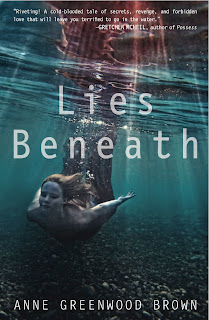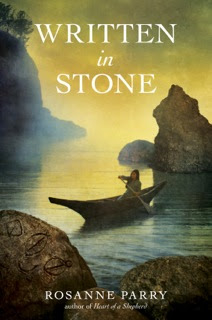When people ask me where I got the idea for LIES BENEATH, a YA novel about murderous mermaids on Lake Superior, I tell them that the initial image came to me in a dream, which is the truth. But the inspiration--the thing that fueled the novel--was Victorian poetry.
I’ve always had a love for the Victorian-era poets: Shelley, Tennyson, Dickinson, Rossetti, and the Brontës, just to name a few. In particular, I’m drawn to the way they mix their images of death and romance: the beautiful corpse, so to speak. For example, Dickinson speaks of death being a suitor come courting in a fine carriage:
Because I could not stop for Death
He kindly stopped for me.
The Carriage held but just Ourselves
And Immortality.
But the Victorians don’t have a monopoly on this juxtaposition of romance and death. It is also a familiar image in modern-day paranormal romance.
 The paranormal genre is filled with vampires, faeries, angels, and mermaids--all beautiful creatures who bring romance to unsuspecting mortals, just as easily as they bring death. So why are we drawn to them? They should repel us, but we are transfixed. Perhaps it is because we long to be consumed by love, just as surely as death will consume us all. Perhaps it’s the notion of “‘til death do us part” taken to its most extreme conclusion.
The paranormal genre is filled with vampires, faeries, angels, and mermaids--all beautiful creatures who bring romance to unsuspecting mortals, just as easily as they bring death. So why are we drawn to them? They should repel us, but we are transfixed. Perhaps it is because we long to be consumed by love, just as surely as death will consume us all. Perhaps it’s the notion of “‘til death do us part” taken to its most extreme conclusion.
LIES BENEATH (the first book in the trilogy) is the story of Calder White, a merman, who falls in love with Lily Hancock, a human girl whose family has a history with monsters in the lake. The novel was inspired by three Victorian poems about beauty, love, and death, all written by Alfred, Lord Tennyson: “The Merman,” “The Mermaid,” and “The Lady of Shalott.”
Tennyson describes the merman as a beautiful creature, living a king’s life. He’s flirtatious and bold, but without real love, his life is lonely, empty, and shallow:
But the mermaids are more straightforward in their warning that death lurks behind the beautiful façade of their lives:
Till that great sea-snake under the sea
From his coiled sleeps in the central deeps
Would slowly trail himself sevenfold
Round the hall where I sate, and look in at the gate
With his large calm eyes for the love of me.
-The Mermaid
In LIES BENEATH, Calder recognizes the emptiness of his life, wants more, but fears he cannot escape his own nature. That is, until he meets Lily Hancock, a modern-day Lady of Shalott.
Like the Lady of Shalott, Lily Hancock lives under a curse. While the Lady is teetering on the edge of a mental breakdown, Lily’s perception of the world is colored by her belief that she is destined for insanity, just like her grandfather before her. Both Lily and the Lady long for love and an end to the curse, even if seeking it out will surely lead to death.
When the Lady sees Lancelot, the object of her desire, Tennyson describes him just as dazzling and golden as he described the merman:
The gemmy bridle glittered free,
Like to some branch of stars we see
Hung in the golden Galaxy.
The bridle bells rang merrily
As he rode down to Camelot:
Both Lily and the Lady put on white dresses, board a boat, and seek an end to their family curse. One of them is successful. The other pays the ultimate price. But can we say they did not both achieve their goal?
Some argue that YA paranormal romance sets a bad example of love for teens. I disagree. I would suggest that argument is looking at the genre through the wrong set of lenses. Rather, if considered through the lens of poetry, the reader quickly realizes that paranormal romance--like so many Victorian-era poems before it--presents a metaphor for sacrificial love. And, in the end, isn’t that the greatest love of all?
Anne Greenwood Brown is the author of Lies Beneath (Random House/Delacorte June 12, 2012), Deep Betrayal (Random House/Delacorte March 12, 2013), and Promise Bound (Random House/Delacorte spring 2014). She lives in Minnesota with her amazingly patient husband and their three above-average children. Follow her on Facebook and Twitter.
Click through to sign up for the National Poetry Month giveaway!
Poetry has been a part of my life for as long as I can remember. My mother and father both read poetry, my father favoring the Rudyard Kipling, Robert Louis Stevenson, and Robert Service variety while my mother was a fan of Frost, Sandburg and Gerard Manley Hopkins. I had a big picture book of poetry I read and reread so often that many of those poems linger in my mind though I never consciously memorized them. "A violet by a mossy stone half hidden from the eye. Fair as a star when only one is shining in the sky" is a line that reliably comes to mind every time I go hiking and find wildflowers clinging to unlikely spots along the trail.

My fourth grade teacher, an exceedingly no-nonsense woman named Ms. Jacques, seemed to have two great loves to communicate to my nine year old self--long division and poetry. She taught me dozens of poetic forms from Haiku to the ballad and (what seems more impressive to me now) showed me how to scan a line to fit the meter of the line before it. I loved the structure of writing to a particular format. Hunting for just the right word to fill out the rhythm or rhyme of a line was so much more game-like than ordinary writing which I detested at the time for its irritating reliance on standard spelling and punctuation. With a poem I could invent words to my heart's debliss and dispense with punctuation entirely.
Ms. Jacques introduced me to my first literary crush, the deliciously uncapitalized e e cummings. Since cummings had neither a first name nor a gender, my nine year old self imagined a pleasant, furry alien who might, should I come across him in my ramblings in the woods, translate for me the poetry of slugs and squirrels and sword ferns.
Eventually college broadened considerably my repertoire of poetry while siphoning off much of the pleasure I found in reading it and all of the joy I took in creating it. I stopped writing poems for years and didn't miss it until I started reading poetry to my own children and writing my own stories.
Novels are so long, I leaned on poetry to give me the satisfaction of something I could finish in a day. When I was stuck or discouraged, poetry gave me a reliable lift and often a fresh perspective on a character. And for all the effort I took over making marketable novels, it was a huge relief to write something that I would not only never sell, but never show anyone. I think having work that lives in my own mind and heart but not in the world is extraordinarily valuable. Jack Gantos would appear to agree with this. He wrote very movingly of his relationship with his unpublished stories in this month's Horn Book Magazine.
So it was a great surprise to me that when a friend asked me to do a poetry event this April that I agreed to write and read my own poems in public. At first the prospect of a public reading filled me with dread. Not that I'm nervous about public performance. I'm far too Irish for that. But I did fear that my poetry would lose its luster if I gave it away. The thing that made the difference was choosing a topic that I cared about. Jim and I decided to write and share poems about love and war--a thing which has touched both our lives. The 10th anniversary of the war in Iraq seemed a good occasion for it.
There is a story I've been thinking about writing for several years, based on the combat experience of one of my nephews. I've begun it and abandoned it several times because I could never quite get the right tone. But I went all the way back to poems I remember my father reading to me, "The Ballad of East and West" by Kipling and "Christmas at Sea" by Stevenson, and decided to write the story as a ballad. I haven't written a ballad since I was nine, but to my amazement, this simple sturdy poetic form fit the story like a glove and what was too hard--too sad--to write in prose, flowed like a stream in verse.
If you happen to be in The Dalles, Oregon on April 18th you'll have a chance to hear what I sincerely hope will be my only poetry reading ever. But it will be worth it for the music and the companionship of fellow poets and the chance to bring a story I've struggled with to light in the form of a poem.
Rosanne Parry is the reluctant poet and enthusiastic author of Heart of a Shepherd, Second Fiddle and the upcoming Written in Stone. www.rosanneparry.com
Meditate, Louise Hawes said. What?
Some writers take acting classes to find a character’s voice, said my then teacher at Vermont College of Fine Arts, but her favorite method was meditation. When you close your eyes and breathe, she promised, you will become your character.
Not me. I was too fidgety; I felt ridiculous sitting on the sofa.
But my writing was flat in my work in progress. I was describing events more than living them through the eyes of Dillon, my protagonist. I was decades away from adolescence, and I needed to get in touch with my inner 13-year-old boy.
The cure? Poetry.
Poetry works as a path to the heart of a character because it requires you to focus on specifics. The red wheelbarrow. A Bird on the Walk. Writing down what you observe in a finite group of words is the beginning of a poem. As Ted Kooser noted in The Poetry Home Repair Manual, “Meaning arrives almost unbidden from an accumulation of specific details.”
Good poetry cannot have generalities. Something stops your mind—a broken laundry basket on the highway median, a hand gripping a child’s lunchbox—and it evokes something in you. Mary Oliver observed, “the poet used the actual, known event or experience to elucidate the inner, invisible experience.”
We know our own internal landscape. The trick, then, is to uncover the invisible landscape of your character. What telling detail will trigger an emotional response in your character?
This exercise has worked for me over and over. I don’t always love the poem I’ve written at the end, but I always feel a new connection to what my character wants. And not coincidentally, the poem usually gives me a scene idea. The specificity of the images gives my character something to do. It’s through doing that character is revealed.
Here’s what happened when I wrote in the voice of Dillon:
Clean Shaven
Mom told me
he shaved off his moustache
right before he left
for Desert Storm
I hold his photo
next to my face
Our eyes match
My nose is hooked
like his
I jut my chin out
checking for a shadow
I run my hand down
my cheek
It’s smooth
like his
in the soldier picture
Ten years gone but
everyone will see
we are father and son
Immediately I knew the core of my novel. The story, which had many other plot twists, was fundamentally about the rebuilding of the relationship between Dillon and his father. Dillon’s every action must stem from a desire to please his father.
So if you are stuck, write a poem. Take a close-up of your character. The short form requires words with impact. Verbs and nouns can’t be weak; the sound and rhythm of the phrases must sing. Words are what matter, after all. Slowly, word by word, sentence by sentence, you will write a novel with characters made real by specific details.
And if it doesn’t work, try meditating.
Jennifer Gennari is the author of My Mixed-Up Berry Blue Summer (Houghton Mifflin Books for Children, 2012), an Association of Booksellers for Children Spring 2012 New Voices title and an American Library Association Rainbow List title. A graduate of Vermont College of Fine Arts and a former reporter, her poems have appeared in the Marin.
Click through to sign up for the National Poetry Month giveaway!
I've been preparing behind the scenes since January, working with eighteen different teachers, readers, librarians, authors, and poets to bring you their thoughts on poetry. For the rest of the month* this space will be devoted to their words. I'm excited to share these wonderful posts with you and to join in the discussion !
4/3 -- Jennifer Gennari :: Opening the Heart of Characters Through Poetry
4/4 -- Paul Hankins :: Coming Back to Poetry and Leaving the Textbook Behind
4/5 -- Lee Wardlaw :: 8 Things I Learned From My Cats About Writing Haiku
4/6 -- Caroline Starr Rose :: Words Inspiring Words -- a Poem for Sharon Creech's LOVE THAT DOG
4/8 -- Lisa Taylor :: Three Poems and Why I Know Them
4/9 -- Gabrielle Prendergast :: Using Acrostic Poetry Both In and Out of the Language Arts Classroom
4/10 -- Paul Janeczko :: Poetry is to Share
4/11 -- Rosanne Parry :: The Reluctant Poet
4/12 -- Anne Greenwood Brown :: Victorian Poets and Paranormal Romance
4/15 -- Jessica Bell :: The Vignette
4/16 -- Augusta Scattergood :: Learning by Heart
4/17 -- Robert L. Forbes :: Looking Out the Window
4/18 -- Laurel Garver :: Stories that Sing -- Poems with a Plot
4/19 -- Amy Ludwig VanDerwater :: Poem Spools -- Stitch by Stitch
4/22 -- Jayne Jaudon Ferrer :: C'mon, Give It Another Chance
4/23 -- Margaret Simon :: The ABC's of Poetry
4/24 -- Kathryn Fitzmaurice :: On Destiny and Emily Dickinson
4/25 -- Kathryn Burak :: First Poems and My Mother -- The Sleever and Muse
4/26 -- Theresa Milstein :: Becoming
4/30 -- Giveaway winner announced
*4/29 We will return to our Lucy Maud Montgomery Read Along discussion briefly before the final poetry post on 4/30.
Giveaway:
 The paranormal genre is filled with vampires, faeries, angels, and mermaids--all beautiful creatures who bring romance to unsuspecting mortals, just as easily as they bring death. So why are we drawn to them? They should repel us, but we are transfixed. Perhaps it is because we long to be consumed by love, just as surely as death will consume us all. Perhaps it’s the notion of “‘til death do us part” taken to its most extreme conclusion.
The paranormal genre is filled with vampires, faeries, angels, and mermaids--all beautiful creatures who bring romance to unsuspecting mortals, just as easily as they bring death. So why are we drawn to them? They should repel us, but we are transfixed. Perhaps it is because we long to be consumed by love, just as surely as death will consume us all. Perhaps it’s the notion of “‘til death do us part” taken to its most extreme conclusion.







Mmmm . . . sounds like just my thing!
Yes!
"We long to be consumed by love"---> powerful! And oh, those covers!!!!
Really enjoyed these snippets of Victorian poetry. I always loved Robert and Elizabeth Browning. "How do I love thee, let me count the ways . . . " Your books sound very intriguing.